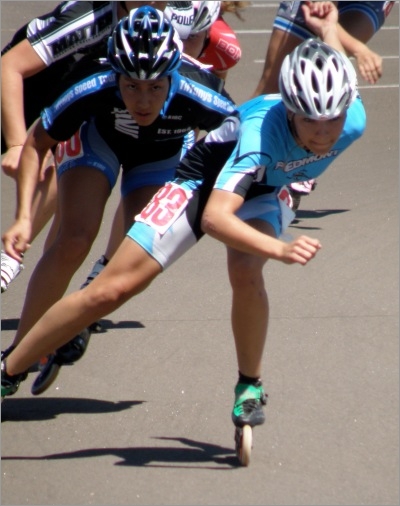 | ||
| ||||||||
By Shannon Valerio
Mollie Brown on top of her wheel at Outdoor Nationals. Photo: Shannon Valerio So you’ve finally made the move up to big wheels. You’re looking forward to a bump in speed. But the first thing you notice when you get on your new skates is that your feet and ankles are wobbly and it feels like your wheels are made of lead. So how are you supposed to get those big wheels moving? The secret is to let the wheels do the work for you. Let’s face it, few of us are ever going to develop the monster strength of the top elite skaters for whatever reason: age, body genetics or training limitations. So it’s unrealistic to expect to double-push big wheels with the ease of a Joey Mantia. But nevertheless, any skater with reasonable strength can reap huge benefits from the extra roll that comes with 100mm and 110mm wheels. Here’s how: 1. Go with the roll. Stay on top of your wheels as much as possible. That means having your wheels straight up and down for as much of your stride as you can. The more up and down your wheels are, the less surface area will touch the road, which means less friction to slow you down. And since you’ll have more roll with big wheels, you won’t need to push off your edges as much. Staying on top of your wheels will also help you adjust to the increased deck height of big wheels. If your ankles do feel wobbly, lock them and keep your wheels vertical. 2. Slow down your stride. In the days of smaller wheels, skaters had to stroke at a relatively fast clip to maintain their speed. But not with big wheels. They do some of the work for you if you learn to let them roll. How? By staying on your recovery leg for as long as possible before stating your next push. This is where the superior “roll” of big wheels comes in. 3. Push forward. This may be the most important thing you learn to get those big wheels rolling. Thrust your recovery skate forward when you land it beneath you. Too many skaters focus on the push to the side or the double push. But it’s the push forward that unlocks the speed of big wheels.
4. Transition. Big wheels can be hard on your back, specifically the muscles and ligaments around the sacroiliac joint (lower back). A good way to help your body adapt is with interval training. Try doing intervals at 70-percent effort for three minutes with three minutes of rest in between. Continue for 30 to 40 minutes. This will help your back adjust to the extra weight and is also one of the most efficient ways of building endurance. Give it some time. And be patient. By slowly adjusting your training and technique, you’ll be rolling away from the competition in no time. ---
Related reading: • Skate Tip of the Week Archive
...
Copyright © 2011 Inline Planet | ||||||||



